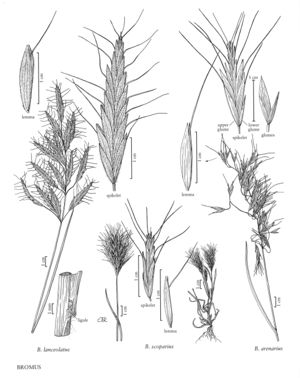Difference between revisions of "Bromus lanceolatus"
FNA>Volume Importer |
imported>Volume Importer |
||
| (4 intermediate revisions by 2 users not shown) | |||
| Line 7: | Line 7: | ||
|synonyms={{Treatment/ID/Synonym | |synonyms={{Treatment/ID/Synonym | ||
|name=Bromus macrostachys | |name=Bromus macrostachys | ||
| − | |authority= | + | |authority= |
| + | |rank=species | ||
}} | }} | ||
|hierarchy=Poaceae;Poaceae subfam. Pooideae;Poaceae tribe Bromeae;Bromus;Bromus sect. Bromus;Bromus lanceolatus | |hierarchy=Poaceae;Poaceae subfam. Pooideae;Poaceae tribe Bromeae;Bromus;Bromus sect. Bromus;Bromus lanceolatus | ||
| Line 19: | Line 20: | ||
-->{{Treatment/Body | -->{{Treatment/Body | ||
| − | |distribution=N.Y.;Alta.;D.C;Tex.;La. | + | |distribution=N.Y.;Alta.;D.C.;Tex.;La. |
| − | |discussion=<p>Bromus lanceolatus grows in waste places, and is also cultivated as an ornamental. It has been introduced to the Flora region from southern Europe, and is reported from scattered sites, e.g., Yonkers, New York (wool waste); College Station, Texas; and Pima County, Arizona.</p> | + | |discussion=<p><i>Bromus lanceolatus</i> grows in waste places, and is also cultivated as an ornamental. It has been introduced to the Flora region from southern Europe, and is reported from scattered sites, e.g., Yonkers, New York (wool waste); College Station, Texas; and Pima County, Arizona.</p> |
|tables= | |tables= | ||
|references= | |references= | ||
| Line 29: | Line 30: | ||
-->{{#Taxon: | -->{{#Taxon: | ||
name=Bromus lanceolatus | name=Bromus lanceolatus | ||
| − | |||
|authority=Roth | |authority=Roth | ||
|rank=species | |rank=species | ||
| Line 37: | Line 37: | ||
|family=Poaceae | |family=Poaceae | ||
|illustrator=Cindy Roché | |illustrator=Cindy Roché | ||
| − | |distribution=N.Y.;Alta.;D.C;Tex.;La. | + | |illustration copyright=Utah State University |
| + | |distribution=N.Y.;Alta.;D.C.;Tex.;La. | ||
|reference=None | |reference=None | ||
|publication title= | |publication title= | ||
|publication year= | |publication year= | ||
|special status= | |special status= | ||
| − | |source xml=https:// | + | |source xml=https://bitbucket.org/aafc-mbb/fna-data-curation/src/200273ad09963decb8fc72550212de541d86569d/coarse_grained_fna_xml/V24/V24_335.xml |
|subfamily=Poaceae subfam. Pooideae | |subfamily=Poaceae subfam. Pooideae | ||
|tribe=Poaceae tribe Bromeae | |tribe=Poaceae tribe Bromeae | ||
Latest revision as of 17:23, 11 May 2021
Plants annual. Culms 30-70 cm, erect or ascending. Sheaths often densely hairy with soft, white hairs; ligules 1-2 mm, hairy, obtuse, erose; blades 10-30 cm long, 3-5 mm wide, glabrous or pubescent. Panicles 5-15 cm long, 2-9 cm wide, erect, densely contracted when immature, more open with age; branches usually shorter than the spikelets, rigid, ascending to slightly spreading, slightly curved or straight. Spikelets 20-50 mm, lanceolate, terete to moderately laterally compressed, often 2+ per node; florets 7-20, bases concealed at maturity; rachilla internodes concealed at maturity. Glumes pilose; lower glumes 5-9 mm, 3-5-veined: upper glumes 8-12 mm, 5-7-veined; lemmas 11-20 mm long, 1.8-2.5 mm wide, lanceolate, pilose, obscurely 7-veined, rounded over the midvein, margins rounded, not inrolled at maturity, apices acute, bifid, teeth shorter than 1 mm; awns 6-12 mm, to 20 mm on some distal lemmas, divaricate when mature, arising 1.5 mm or more below the lemma apices; anthers 1-1.5 mm. Caryopses equaling or slightly shorter than the paleas, thin, weakly inrolled or flat. 2n = 28, 42.
Distribution
N.Y., Alta., D.C., Tex., La.
Discussion
Bromus lanceolatus grows in waste places, and is also cultivated as an ornamental. It has been introduced to the Flora region from southern Europe, and is reported from scattered sites, e.g., Yonkers, New York (wool waste); College Station, Texas; and Pima County, Arizona.
Selected References
None.
